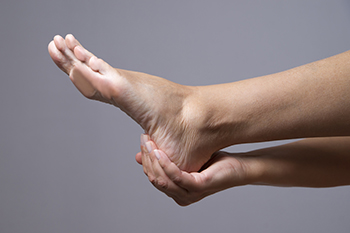 Plantar fibroma is a benign condition characterized by the formation of a knot or nodule in the arch of the foot. This lump occurs in the plantar fascia, which is a thick band of tissue that runs from the heel to the toes. Typically, someone can feel it if they physically examine the foot. A plantar fibroma can develop in one or both feet, and it usually remains stable in size or grows slowly over time. The lump in the arch may or may not be painful. When pain is present, it's often because the fibroma presses against footwear or the ground, creating pressure on the foot. This discomfort can be increased by standing, walking, or wearing tight or unsupportive shoes. People sometimes modify their gait or posture in an attempt to minimize discomfort, which potentially causes secondary pain in the feet, legs, or back. Treatment options vary depending on the severity of symptoms. Conservative options may include orthotic devices and footwear modifications, and more invasive procedures may involve steroid injections or surgery. If you have a lump in the arch of the foot and suspect a plantar fibroma, it is suggested that you make an appointment with a podiatrist for diagnosis and treatment options.
Plantar fibroma is a benign condition characterized by the formation of a knot or nodule in the arch of the foot. This lump occurs in the plantar fascia, which is a thick band of tissue that runs from the heel to the toes. Typically, someone can feel it if they physically examine the foot. A plantar fibroma can develop in one or both feet, and it usually remains stable in size or grows slowly over time. The lump in the arch may or may not be painful. When pain is present, it's often because the fibroma presses against footwear or the ground, creating pressure on the foot. This discomfort can be increased by standing, walking, or wearing tight or unsupportive shoes. People sometimes modify their gait or posture in an attempt to minimize discomfort, which potentially causes secondary pain in the feet, legs, or back. Treatment options vary depending on the severity of symptoms. Conservative options may include orthotic devices and footwear modifications, and more invasive procedures may involve steroid injections or surgery. If you have a lump in the arch of the foot and suspect a plantar fibroma, it is suggested that you make an appointment with a podiatrist for diagnosis and treatment options.
A plantar fibroma may disrupt your daily activities. If you have any concerns, contact Howard Kimmel, DPM of Buckeye Foot Care. Our doctor can provide the care you need to keep you pain-free and on your feet.
Plantar Fibroma
A plantar fibroma is a fibrous knot in the arch of the foot. It is embedded in the plantar fascia which is a band of tissue that extends from the heel to the toes along the bottom of the foot. There can be multiple plantar fibromas in the feet at the same time. There are no known causes for this condition. If you have a plantar fibroma, there will be a bump in the arch of your foot that cannot be missed. Any associated pain is most often due to a shoe rubbing against the nodule. Non-surgical options, such as steroid injections, physical therapy, and orthotics should be tried first. Surgery is a last resort and is the only thing that will remove a plantar fibroma entirely. Consult with a podiatrist for a proper diagnosis and to determine the treatment regimen that is right for you.
What Causes a Plantar Fibroma?
While there are no specific causes identified, a plantar fibroma can possibly come from genetic predisposition or the formation of scar tissue that forms from healing the tears in the plantar fascia.
What Are the Symptoms of a Plantar Fibroma?
There will be a noticeable lump in the arch of the foot that may or may not cause pain. If pain is felt, it is typically because a shoe is rubbing up against the lump or when walking or standing barefoot.
Treatment and Prevention
A plantar fibroma will not disappear without treatment, but it can get smaller and be a non-issue. If pain persists, a podiatrist examines the foot and when the arch of the foot is pressed, pain can be felt down to the toes. An MRI or biopsy might be performed to help diagnose or evaluate the plantar fibroma. The following non-surgical options are generally enough to reduce the size and pain of these nodules:
- Steroid injections
- Orthotics
- Physical therapy to help apply anti-inflammatory creams on the bump
Surgery is considered if the mass increases in size and the patient continues to feel pain after non-surgical methods are tried.
If you have any questions please feel free to contact one of our offices located in Brook Park and Willoughby, OH . We offer the newest diagnostic tools and technology to treat your foot and ankle needs.
